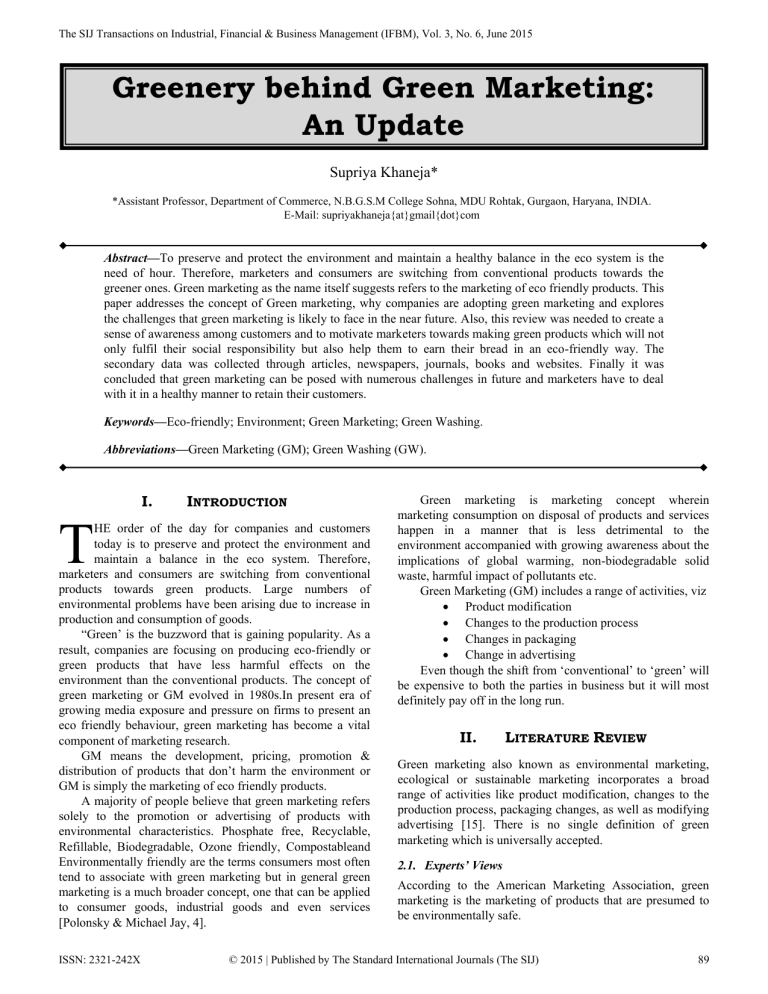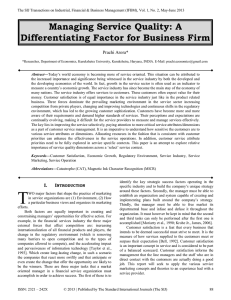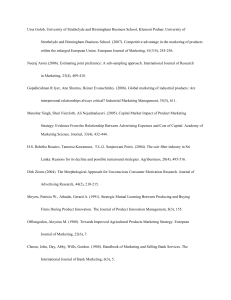Document 14544995

The SIJ Transactions on Industrial, Financial & Business Management (IFBM), Vol. 3, No. 6, June 2015
Greenery behind Green Marketing:
An Update
Supriya Khaneja*
*Assistant Professor, Department of Commerce, N.B.G.S.M College Sohna, MDU Rohtak, Gurgaon, Haryana, INDIA.
E-Mail: supriyakhaneja{at}gmail{dot}com
Abstract— To preserve and protect the environment and maintain a healthy balance in the eco system is the need of hour. Therefore, marketers and consumers are switching from conventional products towards the greener ones. Green marketing as the name itself suggests refers to the marketing of eco friendly products. This paper addresses the concept of Green marketing, why companies are adopting green marketing and explores the challenges that green marketing is likely to face in the near future. Also, this review was needed to create a sense of awareness among customers and to motivate marketers towards making green products which will not only fulfil their social responsibility but also help them to earn their bread in an eco-friendly way. The secondary data was collected through articles, newspapers, journals, books and websites. Finally it was concluded that green marketing can be posed with numerous challenges in future and marketers have to deal with it in a healthy manner to retain their customers.
Keywords— Eco-friendly; Environment; Green Marketing; Green Washing.
Abbreviations— Green Marketing (GM); Green Washing (GW).
I.
I
NTRODUCTION
T HE order of the day for companies and customers today is to preserve and protect the environment and maintain a balance in the eco system. Therefore, marketers and consumers are switching from conventional products towards green products. Large numbers of environmental problems have been arising due to increase in production and consumption of goods.
“Green‟ is the buzzword that is gaining popularity. As a result, companies are focusing on producing eco-friendly or green products that have less harmful effects on the environment than the conventional products. The concept of green marketing or GM evolved in 1980s.In present era of growing media exposure and pressure on firms to present an eco friendly behaviour, green marketing has become a vital component of marketing research.
GM means the development, pricing, promotion & distribution of products that don‟t harm the environment or
GM is simply the marketing of eco friendly products.
A majority of people believe that green marketing refers solely to the promotion or advertising of products with environmental characteristics. Phosphate free, Recyclable,
Refillable, Biodegradable, Ozone friendly, Compostableand
Environmentally friendly are the terms consumers most often tend to associate with green marketing but in general green marketing is a much broader concept, one that can be applied to consumer goods, industrial goods and even services
[Polonsky & Michael Jay, 4].
Green marketing is marketing concept wherein marketing consumption on disposal of products and services happen in a manner that is less detrimental to the environment accompanied with growing awareness about the implications of global warming, non-biodegradable solid waste, harmful impact of pollutants etc.
Green Marketing (GM) includes a range of activities, viz
Product modification
Changes to the production process
Changes in packaging
Change in advertising
Even though the shift from „conventional‟ to „green‟ will be expensive to both the parties in business but it will most definitely pay off in the long run.
II.
L
ITERATURE
R
EVIEW
Green marketing also known as environmental marketing, ecological or sustainable marketing incorporates a broad range of activities like product modification, changes to the production process, packaging changes, as well as modifying advertising [15]. There is no single definition of green marketing which is universally accepted.
2.1.
Experts’ Views
According to the American Marketing Association, green marketing is the marketing of products that are presumed to be environmentally safe.
89 ISSN: 2321-242X © 2015 | Published by The Standard International Journals (The SIJ)
The SIJ Transactions on Industrial, Financial & Business Management (IFBM), Vol. 3, No. 6, June 2015
Polonsky & Michael Jay [4] defined green marketing as all activities designed to generate and facilitate any exchanges intended to satisfy human needs or wants, such that the satisfaction of these needs and wants occurs, with minimal detrimental impact on the natural environment.
According to Peattie [5] GM is the holistic management process responsible for identifying, anticipating and satisfying the requirements of customers and society, in a profitable and sustainable way.
The marketing or promotion of a product based on its environmental performance or an improvement thereof is GM
[Charter & Polonsky, 6].
The evolution of GM has three phases according to
Peattie [7].
Phase 1
• "Ecological" green marketing
Phase 2
• "Environmental" green marketing
Phase 3
• "Sustainable" green marketing
Figure 1: Evolution of Green Marketing (GM)
First phase was termed as “Ecological” green marketing. It incorporates all marketing activities which were concerned to help environment problems and provide remedies for environmental problems.
Second phase was “Environmental” green marketing and the focus shifted on clean technology that involved designing of innovative new products, which take care of pollution and waste issues.
Third phase was “Sustainable” green marketing. It came into prominence in the late 1990s and early
2000. GM is a vital constituent of the holistic marketing concept.
2.2.
Some Examples
Companies which followed the green marketing concept:
LG, McDonalds, Wipro, IBM, Marks & Spencer group,
Wal-Mart, Coca cola, Toyota, Honda, Dell, Tesco, Starbucks,
Surf excel, Xerox, Heineken, Unilever, Philips etc.
McDonald's replaced its clam shell packaging with waxed paper because of increased consumer concern relating to polystyrene production and Ozone depletion [Giffor, 2; Scott Hume, 3]
Tuna manufacturers modified their fishing techniques because of the increased concern over driftnet fishing, and the resulting death of dolphins
[Advertising Age, 1]
Xerox introduced a “high quality” recycled photocopier paper in an attempt to satisfy the demands for less environmentally harmful products.
III.
O BJECTIVES
The main objective of this paper is to understand the emerging concept of Green marketing, why companies are adopting this and to explore the challenges that green marketing is likely to face in the near future [Babita Saini,
14].
IV.
R
ESEARCH
M
ETHODOLOGY
Secondary data was used to collect the information and the same was collected through online articles, newspapers, magazines, books, journals, conference proceedings, government reports and various websites.
V.
D
ISCUSSION
5.1.
The Greenery Behind
In addition to helping boost sales, green marketing can help companies to reduce operating and production costs, specifically by lowering the energy usage. Environmentally sensitive companies are more attractive to potential employees who seek to become a part of a positive corporate culture.
When a business uses energy efficient lighting, heating and cooling, reduces its water use, recycles office materials, organizes employee community cleanup activities, uses recycled materials and creates less waste, it generates positive public relations in its community and industry and with the customers in particular. It can advertise itself as a „green company‟ or its products as „green ’ on its product packaging, in its advertising and on its website. This can create brand preference or loyalty and boost sales and profits. Green marketers also can qualify as vendors or suppliers with government agencies and firms that prefer to do these types of businesses.
These days most of the important companies have
Corporate Social Responsibility that includes their environmental priorities.
Green and Black's chocolate bar, Yeo Valley Organic etc are the success stories in the history of green marketing
[Sarkar Anirban, 12].
Dr. Woersdorfer‟s findings echo about green marketing success stories. A few of these are listed here below:
O‟Power, which markets an innovative energy billing system that shows homeowners how much more or less energy they‟re consuming than their neighbours.
FreeRice, an UN-run social giving application that lets frequent gamers register to publicly display their wins.
PracticallyGreen‟s green living scorecard
Minimonos online virtual world for kids
Recyclebank®, the company that rewards people for taking everyday green actions with discounts and deals, which recently announced a partnership with
Research and Google to measure how gaming
ISSN: 2321-242X © 2015 | Published by The Standard International Journals (The SIJ) 90
The SIJ Transactions on Industrial, Financial & Business Management (IFBM), Vol. 3, No. 6, June 2015 techniques can impact individuals‟ behaviours when applied to environmental causes [17].
5.2.
Benefits of Going Green
Key benefits of going green are as follows [Mary Wanjiru
Kinoti, 10; Rahul Singal & Anuradha Garg, 13]:
5.2.1.
Cut Throat Competition
Organisations are facing cut throat competition from its competitors and their environmental activities are putting pressure on them to modify their marketing activities. Many companies have gained additional market share by using this green concept. The actions of one company have caused an entire industry to modify its environmental behaviour.
5.2.2.
Government Pressure
It is also essential for the organisations to comply with environmental legislation. Government regulations are forcing them to be more environmentally responsible.
Government is trying to protect consumers and society by minimizing the impact of business on the environment.
For example, they are putting efforts to reduce production of harmful goods, modify consumer and industry‟s use of detrimental goods and ensure that businesses provide accurate information on the environmental aspects of their activities.
5.2.3.
Social Responsibility
It is the moral obligation of companies to be socially responsible. Many companies realize that they are a part of the community and must behave in an environmentally responsible way. In some cases, concern for environmental issues has become integrated into the company‟s culture.
5.2.4.
Profits or Cost Issues
Cost factors associated with waste disposal or reductions in material usage are forcing companies to modify their behaviour. By adopting green marketing, they can increase their sales and market share which can yield them higher profits as consumers are now moving towards green products.
5.2.5.
Miscellaneous Advantages of GM
Increasing awareness among consumers over the past years has resulted into consumer preferring green products and services. This will also lead to effective utilisation of the scarce resources of nation.
5.3.
Green Washing
Green Washing (GW) is presenting a product or service as
„green when it's not green‟. It is a form of spin in which green marketing is deceptively used to promote the perception that an organization's products, aims or policies are environmentally friendly when these are not in a real sense.
One of the main problems is that firms using GM must ensure that their activities are not misleading to consumers or industry and do not breach any of the regulations or laws dealing with environmental marketing.
The U.S.-based watchdog group CorpWatch defines green wash as “the phenomena of socially and environmentally destructive corporations, attempting to preserve and expand their markets or power by posing as friends of the environment.”
GW is the unjustified appropriation of environmental virtue by a company, an industry, a government, a politician or even a non-government organization to create a proenvironmental image, sell a product or a policy, or to try and rehabilitate their standing with the public and decision makers after being embroiled in controversy [16].
VI.
C ONCLUSION
Consumers have a strong positive attitude towards „Green
Marketing‟ as shown by research findings and consumers are now more aware of it [Hemantha, 11]. More and more consumers will prefer green products in the coming years.
But there are a few hurdles in the path to have a totally environment friendly or a „Green society‟.
Expensive process requires huge investment in technology.
Lacks of awareness among consumers especially in rural areas are not aware of green products and services available in the market.
There is a need for standardization to verify labelling and licensing of green products and marketers do have to cope up with these challenges
[Grant, 8; Pavan Mishra & Payal Sharma, 9].
R
EFERENCES
[1] Advertising Age (1991), “Spurts and Starts: Corporate Role in
'90s Environmentalism Hardly Consistent”, Advertising Age ,
Vol. 62, No. 46, Pp. GR14–GR16.
[2] B. Gifford (1991), “The Greening of the Golden Arches-
McDonald's Teams with Environmental Group to Cut Waste”,
The San Diego Union , S, Pp. C1–C4.
[3] Scott Hume (1991), “McDonald's: Case Study”, Advertising
Age , Vol. 62, No. 5, Pp. 32.
[4] Polonsky & Michael Jay (1994), “An Introduction to Green
Marketing”, Electronic Green Journal , Vol. 1, No. 2, Pp. 1–10.
[5] K. Peattie (1995), “Environmental Marketing Management”,
Pitman Publishing , 1, London.
[6] M. Charter & M.J. Polonsky (1999), “Greener Marketing: A
Global Perspective on Greening Marketing Practice”,
Greenleaf Publishing , 2, Sheffield, UK.
[7] K. Peattie (2001), “Towards Sustainability: The Third Age of
Green Marketing”, The Marketing Review , Vol. 2, Pp. 129–
146.
[8] J. Grant (2008), “The Green Marketing Manifesto”, John Wiley
& Sons Ltd , 1, England, Pp. 47–51.
[9] Pavan Mishra & Payal Sharma (2010), “Green Marketing in
India: Emerging Opportunities and Challenges”, Journal of
Engineering, Science and Management Education , Vol. 3, Pp.
9–14.
[10] Mary Wanjiru Kinoti (2011), “Green Marketing Intervention
Strategies and Sustainable Development: A Conceptual Paper”,
International Journal of Business and Social Science , Vol. 2,
No. 23, Pp. 263–273.
ISSN: 2321-242X © 2015 | Published by The Standard International Journals (The SIJ) 91
The SIJ Transactions on Industrial, Financial & Business Management (IFBM), Vol. 3, No. 6, June 2015
[11] Y. Hemantha (2012), “Green Marketing- An Exploratory
Research on Consumers in Bangalore City”, Abhinav Journal ,
Vol. 1, No. 9, Pp. 84–97.
[12] Sarkar Anirban (2012), “Green Marketing and Sustainable
Development-Challenges and Opportunities”, International journal of Marketing, Financial Services & Management
Research , Vol. 1, No. 9, Pp. 120–134.
[13] Rahul Singal & Anuradha Garg (2013), “Green Marketing:
Challenges and Opportunities”, International Journal of
Innovations in Engineering and Technology , Vol. 2, No. 1, Pp.
470–474.
[14] Babita Saini (2014), “Green Marketing in India: Emerging
Opportunities and Challenges”, IOSR Journal of Business and
Management , Vol. 15, No. 6, Pp. 67–73.
[15] http://en.wikipedia.org/wiki/Green_marketing
[16] http://www.sourcewatch.org/index.php/Greenwashing
[17] http://www.commpro.biz/marketing/smart-green-marketingtrends-5-examples-and-tips-for-reaching-mainstreamconsumers.
Supriya Khaneja .
I am an M.Com. from
Department of Commerce, Kurukshetra university, Kurukshetra. Currently I am working as an Assistant Professor in
Commerce Department, N.B.G.S.M College,
Gurgaon. Also I am pursuing PhD in
Commerce from Amity University, Gurgaon.
My primary interest area is Marketing and
Accounting.
ISSN: 2321-242X © 2015 | Published by The Standard International Journals (The SIJ) 92





